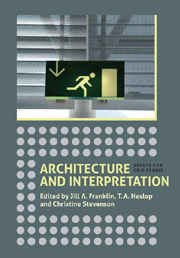Book contents
- Frontmatter
- Contents
- List of Illustrations
- Preface: In Appreciation
- List of contributors
- 1 Introduction
- Incitements to Interpret in Late Antique and Medieval Architecture
- 16 Believing is Seeing: The Natural Image in Late Antiquity
- 42 Articulation as an Expression of Function in Romanesque Architecture
- 60 Barrel-Vaulted Churches in Late Medieval Scotland
- 78 Augustinian and Other Canons' Churches in Romanesque Europe: The Significance of the Aisleless Cruciform Plan
- 99 Towers and Radiating Chapels in Romanesque Architectural Iconography
- 111 Diffusion, Imitation and Evolution: The Uncertain Origins of ‘Beakhead’ Ornament
- 128 Architecture and Pattern: The Western Façade of Lincoln Cathedral and Modernist Reference Points for its Interpretation
- Authors and Intentions
- Architecture beyond Building
- Index
99 - Towers and Radiating Chapels in Romanesque Architectural Iconography
from Incitements to Interpret in Late Antique and Medieval Architecture
Published online by Cambridge University Press: 05 April 2013
- Frontmatter
- Contents
- List of Illustrations
- Preface: In Appreciation
- List of contributors
- 1 Introduction
- Incitements to Interpret in Late Antique and Medieval Architecture
- 16 Believing is Seeing: The Natural Image in Late Antiquity
- 42 Articulation as an Expression of Function in Romanesque Architecture
- 60 Barrel-Vaulted Churches in Late Medieval Scotland
- 78 Augustinian and Other Canons' Churches in Romanesque Europe: The Significance of the Aisleless Cruciform Plan
- 99 Towers and Radiating Chapels in Romanesque Architectural Iconography
- 111 Diffusion, Imitation and Evolution: The Uncertain Origins of ‘Beakhead’ Ornament
- 128 Architecture and Pattern: The Western Façade of Lincoln Cathedral and Modernist Reference Points for its Interpretation
- Authors and Intentions
- Architecture beyond Building
- Index
Summary
ST LAWRENCE at Godmersham in Kent is principally renowned as the church attended by Jane Austen when staying at Godmersham Park. For the medievalist, however, it is better known for its tower (figs 1 and 2). This has an apse projecting from its east wall, prompting some to describe it as a survival or adaptation of the Anglo-Saxon tower-nave arrangement, as at Barton-on-Humber (Lincolnshire) and Earl's Barton (Northamptonshire). This paper will attempt to show that the tower at Godmersham was never free-standing, however, and that it is an excellent illustration of the deliberate use of architectural iconography, hitherto unrecognised.
The tower at Godmersham lies at the division between nave and chancel, on the north side of the church, and the large arch connecting it with the nave gives it the character of a transept arm. The building has a wide south aisle built in 1865. The chancel is very slightly narrower than the nave. Some early masonry survives to each side and it is possible that an apsidal east end was replaced during the early thirteenth century by a flat east wall displaying lancet windows.
The north and west walls of the nave and the earliest parts of the north and south walls of the chancel have been dated to the Anglo-Saxon period on the evidence of the rubble and Roman brick quoins at the north-west corner of the nave, and because of the use of a local ferruginous sandstone which, it is argued, would not have been employed after the arrival of the Normans and their Caen limestone.
- Type
- Chapter
- Information
- Architecture and InterpretationEssays for Eric Fernie, pp. 99 - 110Publisher: Boydell & BrewerPrint publication year: 2012



